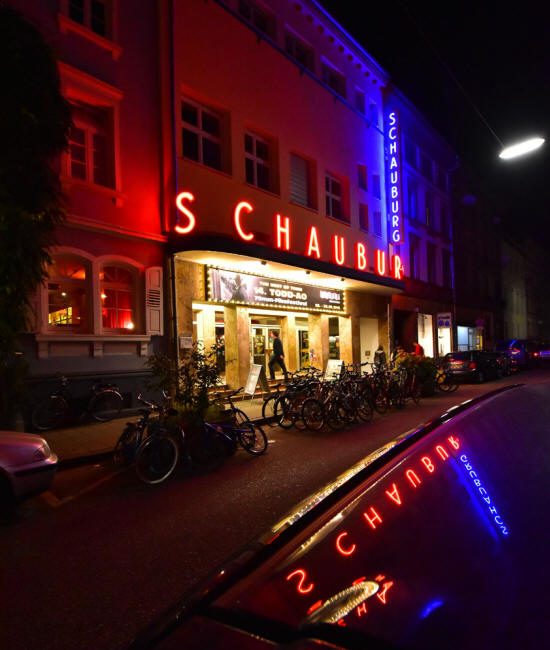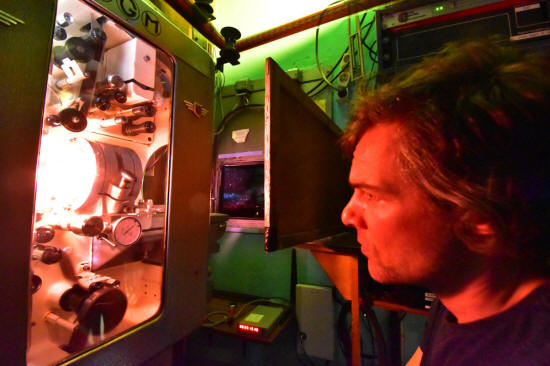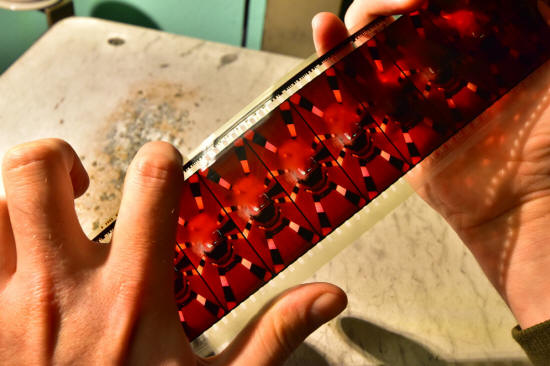Impressions from 70mm weekend in Karlsruhe 2018 |
Read more at in70mm.com The 70mm Newsletter |
| Written by: Hans Haenssler, Stuttgart, Germany | Date: 13.10.2018 |
 The
historic Schauburg Cinerama theatre in all its neon glory. Picture by Thomas
Hauerslev The
historic Schauburg Cinerama theatre in all its neon glory. Picture by Thomas
HauerslevMy personal impressions of the 70mm weekend in Karlsruhe 2018. As usual, there was a warm-up on Thursday evening with "SAMSARA" filmed in Panavision System 65, but never released in the 70mm format. So it was a 4k digital projection. The same applied to "SAVAGE PAMPAS" filmed in MCS 70 - Superpanorama and digitized from a used 70mm theatre print with 6-track magnetic sound. The dialogue had very directional mixing but the music from Waldo de Los Rios was awful. Anyway Dieter Gäbler from Munich was responsible for handling the MCS camera and the great depth effect of the filmed location in Spain was amazing. But these are the experiences I had before at the Schauburg so I think it was the same on Thursday evening. I was not there, because I came on Friday morning to Karlsruhe. I heard that there were not too many people attending the warm-up shows. Friday September 28 opened with a blow up print of "HOFFA" from 1992 in very good condition with all the colours intact and 6 channel Dolby A magnetic sound with German dialogue. Jack Nicholson played the role of Jimmy Hoffa and Danny DeVito played his loyal friend. De Vito also was the director of the film which had a running time of 140 minutes. There were nice camera movements and cuts in the storytelling from today and yesterday. As on every festival occasion, there was coffee and cake offered in the early afternoon in the foyer and since it was nice weather, we could sit outside and enjoy some sunshine on our faces. At 16.00 hr "Dersu Uzula" was shown in the Russian original version with Danish and German subtitles projected from the video projector of the Schauburg. The story was filmed from 1973 to 75 in Sovscope 70 (70mm negativ film) under the direction of Akira Kurosawa and now shown for the second time in Karlsruhe. There were good colours still left in the print and good 6 track magnetic sound reproduction. An officer and his men are on surveying duty in some almost impassable terrain and encounter an old Kyrgyz nomad who becomes a pathfinder, guide and friend. Due to poor eysight the officer invites Dersu to live in his hometown. He is desperately unhappy in this environment, in spite of his close friendship with the officer and finally returns to the isolation of the wilderness and dies The storytelling was very slow, but with very beautiful photography. The print had only some splices and the sound was discrete stereo. Then it was time for the traditional dinner/buffet in the foyer featuring very tasty dishes.. "WEST SIDE STORY" was presented in a 70mm print struck about 8 years ago, from inter negatives derived from who knows how many generations. The film was shot in Super Panavision 70 in 1961 and the new print did not retain the quality of the first run. Moreover, the 6 channel DATASAT sound was filtered too much, so most of the dynamic range across the 5 front speakers lacked the punch and power of the original print from 1961. Naturally, the show was screened in the original English version, complete with intermission, entr'acte music and full length end credits. Quite rightly, filmed in Panavision 70 was also included in the end credits. Refreshment were served in the foyer at 22.45h at the Get Together starring Hoepfner beer. There was convivial conversation amongst the many visitors and fans of the festival. They hailed from the USA, UK, Japan, Denmark, Sweden, Austria and of course Germany. |
More in 70mm reading: Mark Lyndon's Karlsruhe Impressions Sebastian Rosacker's Karlsruhe Impressions 14. Todd-AO 70mm-Festival. 28 - 30. September, 2018 Impressions from the KRRR! 70 film fest in Krnov (Czech Republic) from April 13 - 15, 2018 Internet link: |
 Markus
Vetter, the projectionist, working with the historic Todd-AO DP70 projector.
Picture by Thomas Hauerslev Markus
Vetter, the projectionist, working with the historic Todd-AO DP70 projector.
Picture by Thomas HauerslevA full breakfast was on offer to weekend pass holders to the Schauburg from 10.00 am on Saturday and Sunday morning. At 11 am, .a clear but faded 70mm print of "BLADE RUNNER" was screened. Derived from a 35mm anamorphic blow up in Panavision (anamorphic) and 65mm elements for special effects photography, it featured 6-track Dolby A magnetic sound in the German dubbed version. There were many splices in the print, most of them missing only a few frames (maybe someone was collecting film cells?) This was not only at the head and end of each reel but also in between. The stereophonic music of the Vangelis score had good sound quality but the surround was not divided in left and right (split surround) as announced. After coffee and cake at 14.30h, we saw the new version of "Murder on the Orient Express" by Kenneth Brannagh,. He also played Poirot. It was filmed in Panavision System 65 and presented with 6-track DATASAT digital sound. The film was made in 2017 and shown in the original English version with German subtitles. Most of the action scenes were filmed in a studio set in England, with some external shots in Switzerland with the train running through countryside in winter; but lacking any Cinerama effects in the picture. The music by Patrick Doyle had some nice cues. Since I am not a fan of Agatha Christie stories I just watched the beginning with the not so good digital or analogue matte paintings of Jerusalem and Istanbul featured in the long shots. Todd-AO or any other 65mm system in the ‘60s, for that matter looked so much better. At 17.00h the 1968 DEFA production, starring Manfred Krug was the comedic story of "HAUPTMAN FLORIAN VON DER MÜHLE" (CAPTAIN FLORIAN OF THE MILL) filmed in DEFA 70; was another encounter with the print from the Czech Republic. This is the one and only print extant, as they told us in the introduction of the show. The former captain claims reparation for damage to his mill after the Napoleonic wars and must go through a lot of turbulent action which culminates in a happy ending. Thanks to ORWO elements the print still retained good colour quality and the 6-track magnetic sound was discrete with good dialogue mixing and very effectively recorded stereophonic music. With 132 minutes running time, there was an intermission after about 90 minutes. At 19.30h dinner buffet was served, this time featuring a splendid barbecue in the garden. |
|
 7OMM
Film. Picture by Thomas Hauerslev 7OMM
Film. Picture by Thomas HauerslevNext in the evening program we saw "2OO1: A Space Odyssey" projected from a newly struck print. It was not taken from the original camera negative and had 6 channel DATASAT digital sound. By the way, this was the first title screened after the reconstruction of the Schauburg in 1968 as a so called Super Cinerama theatre. At that time it had a balcony and a pair of DP75 projectors in the new installed projection room on the ground floor. Sadly, the quality of the Super Panavision 70mm film we witnessed was not the same as the first run or later in newly struck prints made with magnetic sound. There was a touch of green in the grey shadows, It was especially noticeable in the scenes with the orbit station before the travel scenes to the moon. You also could see the foils used for the front projection of the ape scenes in the beginning of the film. The print already had scratches in the new print, caused by a too big loop having emerged from the film gate in one of the cinemas where the print had been run. Thus, I watched this print only up to the point when the space shuttle landed on the moon station. After our lavish buffet breakfast on Sunday, there was a new lecture by Thomas Hauerslev, the creator of the "in70mm.com" website about all things Todd-AO and how it all started. After the smash success of Cinerama 1952 in New York, Michael Todd who was involved in the European scenes of the production; wanted to have a reliable system free of the join-lines between the 3 single panel images and also a less laborious technical setup for the presentation of a wide angle view, similar to Cinerama. The result was 65mm rolling stock exposed with brand new optics created by the American Optical Company mounted on refurbished Mitchell camera bodies taken from storage There was a newly developed 6 track magnetic sound system added to the 70mm prints. Philips DP70 projectors were offered to cinema owners for the exhibition of Todd-AO pictures. Thomas screened a digital print of test footage, specially created to convince Rogers & Hammerstein to use the new system for filming "Oklahoma". For the first time ever, we saw some specifically corrected 70mm excerpts from the films musical numbers. The correction was specifically made for theatres which had an extreme downward projection angle from the projection booth. |
|
 Todd-AO
Festival posters on display here and there in the city. Picture by Thomas
Hauerslev Todd-AO
Festival posters on display here and there in the city. Picture by Thomas
HauerslevAfter the lecture there was the short film "A Year Along the Abandoned Road" by Morten Skallerud shown on the deeply curved Cinerama screen. This 12 minute production was filmed with 70mm Super Panavision rolling stock in 1 frame by frame shots on a time travel journey along a road in Børfjord [in Norway]. The director Morten Skallerud was presented the film in person and afterwards answered questions from the audience. He also showed his IMAX short film "Where the Trains Used to Go" from 2003. This was also filmed frame by frame when tracking the camera along, so it looked rather like Steadicam. Another bonbon "SKY OVER HOLLAND" filmed in MCS 70 Superpanorama finished the morning program. It was a very good print filmed by Robert Gaffney and Douwes Fernhout from the year 1967. It had a 6-channel magnetic soundtrack. Then there was enough time to take a closer look at the MCS 70 camera set up in the foyer by owner Jürgen Brückner, along with a new 65mm camera from Tommy Madsen as well as his new build Super 8 camera, with built in video assistant viewfinder. These were very interesting exhibits. "Phantom Thread" 2017 was screened in 70mm in the original English version. It was filmed in [3-perf] Panavision 35mm spherical and 1.85 aspect ratio with 6-track DATASAT digital sound. It starred Daniel Day-Lewis and Vicky Krieps. It was a curious tale about a fashion designer in Haute Couture in London in the 50s. Winning one Oscar for best costume design it had some kind of love story going on with a young waitress from Switzerland who had to maintain her position in the house of the fashion designer and his sister. The picture quality was very sharp and had that characteristic blue touch in the grey scenes, so well known from FOTEKEM in LA. From the series of Tati films "Playtime" in 70mm was put on display. The new print made a few years ago [2002] in France had very good colour quality and a sharp 1:85 image. It was filmed with a 65mm Mitchell camera and a great sound recording (mostly sound effects almost no dialogue). The film was made in 1965 in the outskirts of Paris, where Tati was building his own Paris in the so called "Tati Town". Miniature sets looking like real high rise buildings showed Paris complete with American tourists coming to town. So all they see are modernistic exhibition halls, offices made of glass and an unfinished high end restaurant constantly developing in the course the evening. Playtime was not a great success on its first run in Germany. Paradoxically, it was the best attended film show of the 2018 Karlsruhe Todd AO festival. After dinner there was something for younger 70mm fans as well as the final film in The 2018 Todd AO Festival. Screened at 20.30h in 70mm, "Ready Player One" was filmed in Panavision 35 Scope format, complete with digital effects, so the players mostly acted in front of green screen backgrounds The 6-track DATASAT sound was full level and the picture quality outstanding. It was the original print with English dialogue. Steven Spielberg directed and Michael Kahn with his 82 years’ experience, did the editing honours. The story played out in the virtual world of OASIS. A teenager with his avatar fought valiantly against a mega conglomerate and won in the end. Since John Williams was not available for the score Alan Silvestri took over the job, so there was no melodic music in the film, only a kind of rough and heavy orchestration in the score. And that was the end of the festival but there was still time to visit the Wolfs Bräu around the corner. All in all, it was another great experience with some new titles never seen before. So I would like to thank Herbert Born for arranging the festival, Marcus and Vincent for their perfect projection of the prints and all the other nice and friendly people working in the background of the operation. Ladies and Gentlemen, I give you the "14. Todd-AO 70mm-Festival". |
|
| Go: back - top - back issues - news index Updated 22-01-25 |
